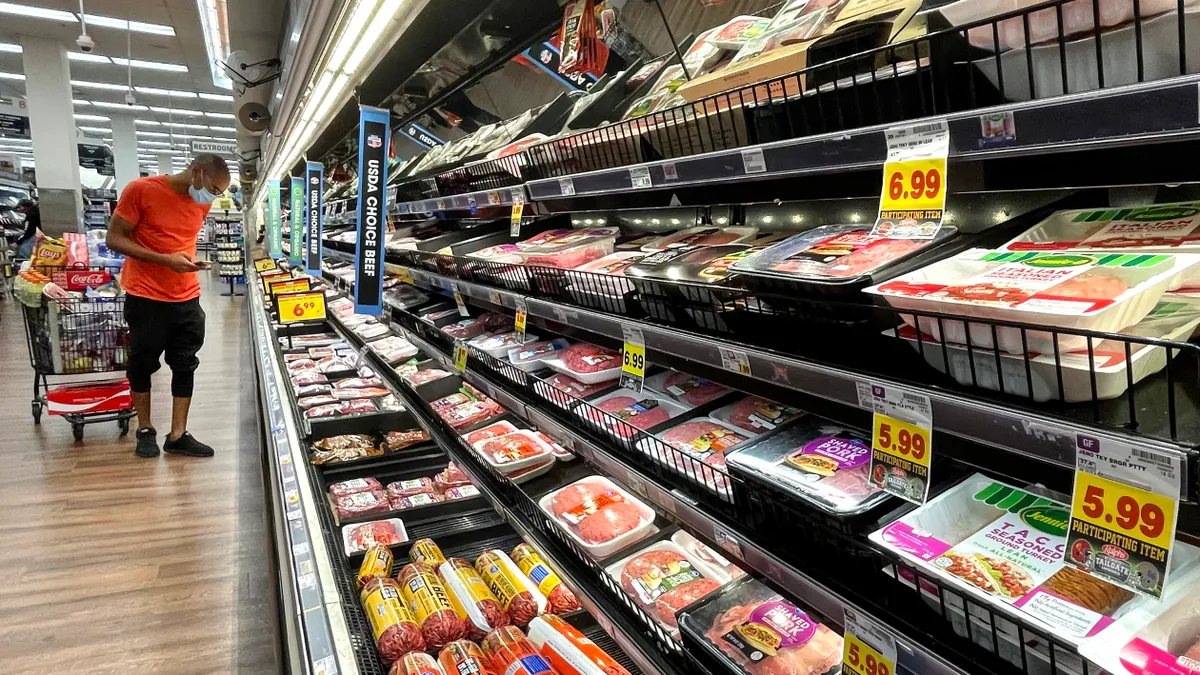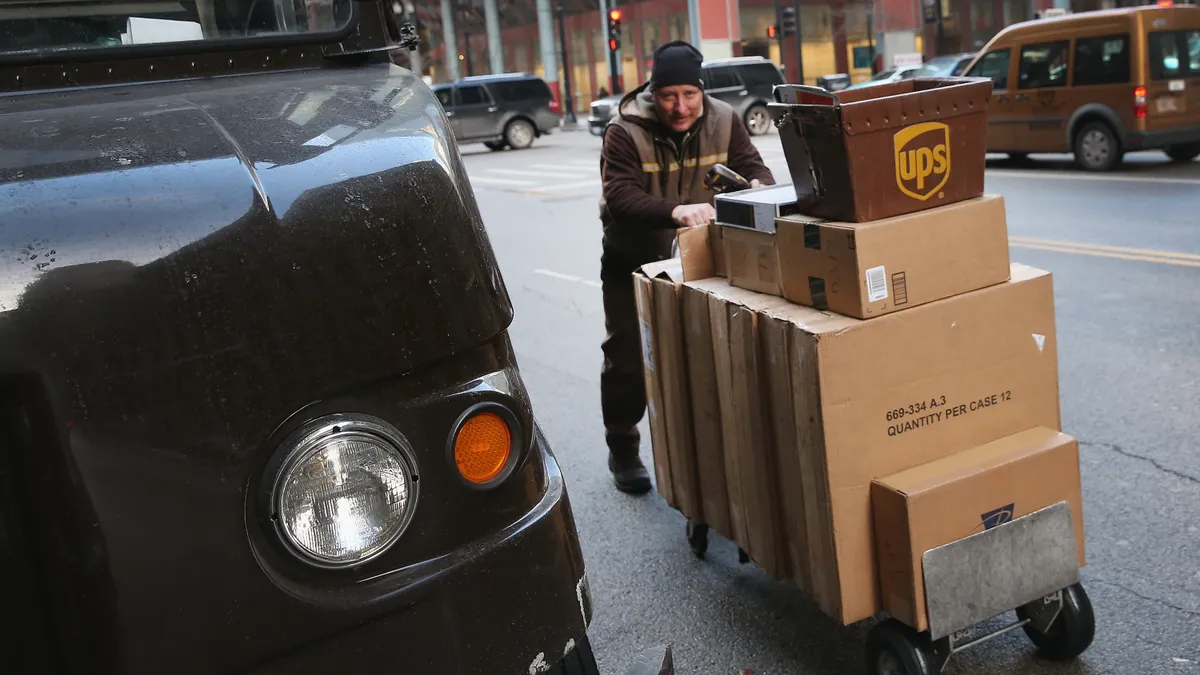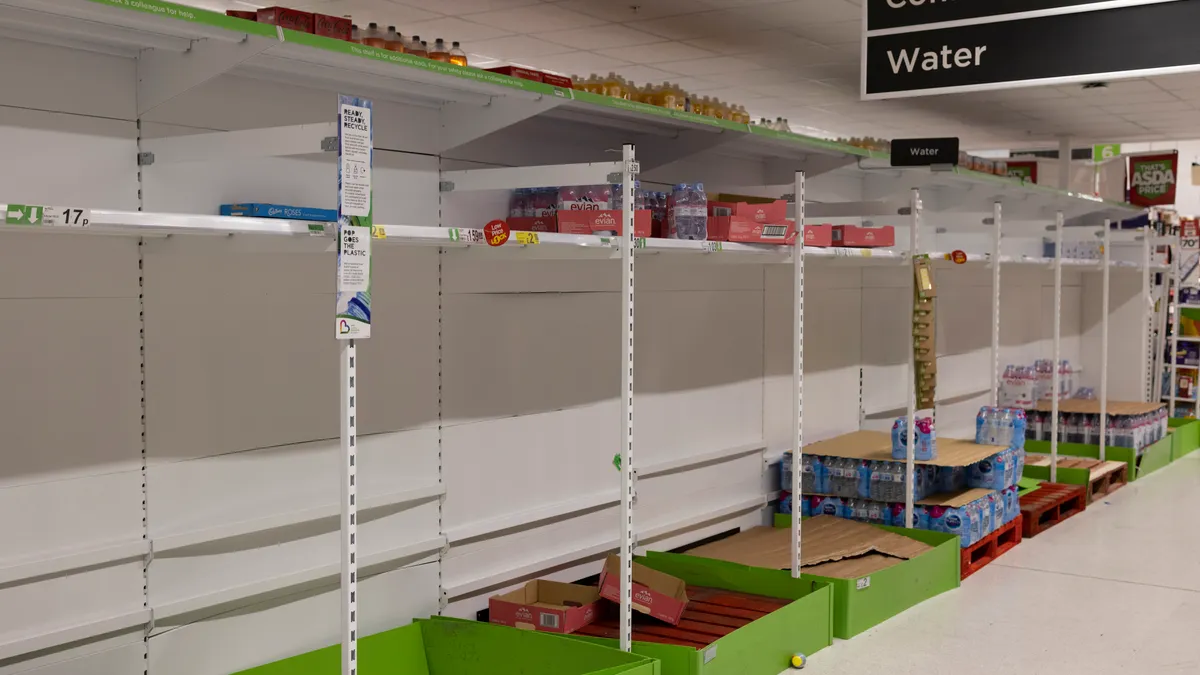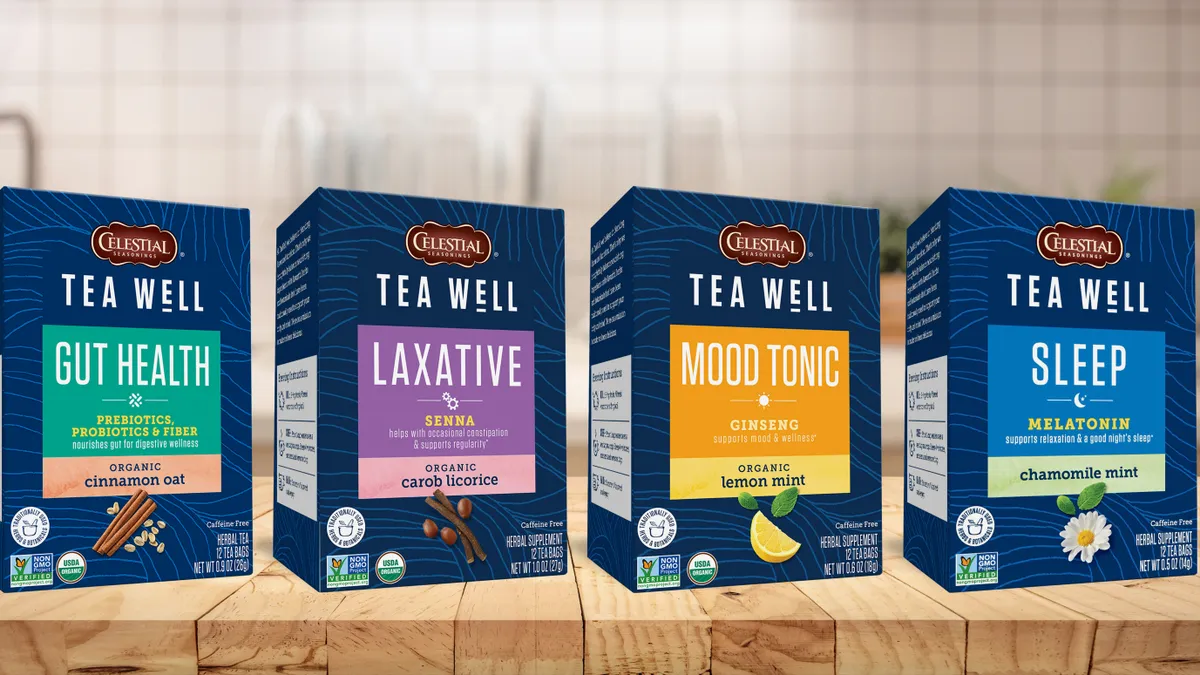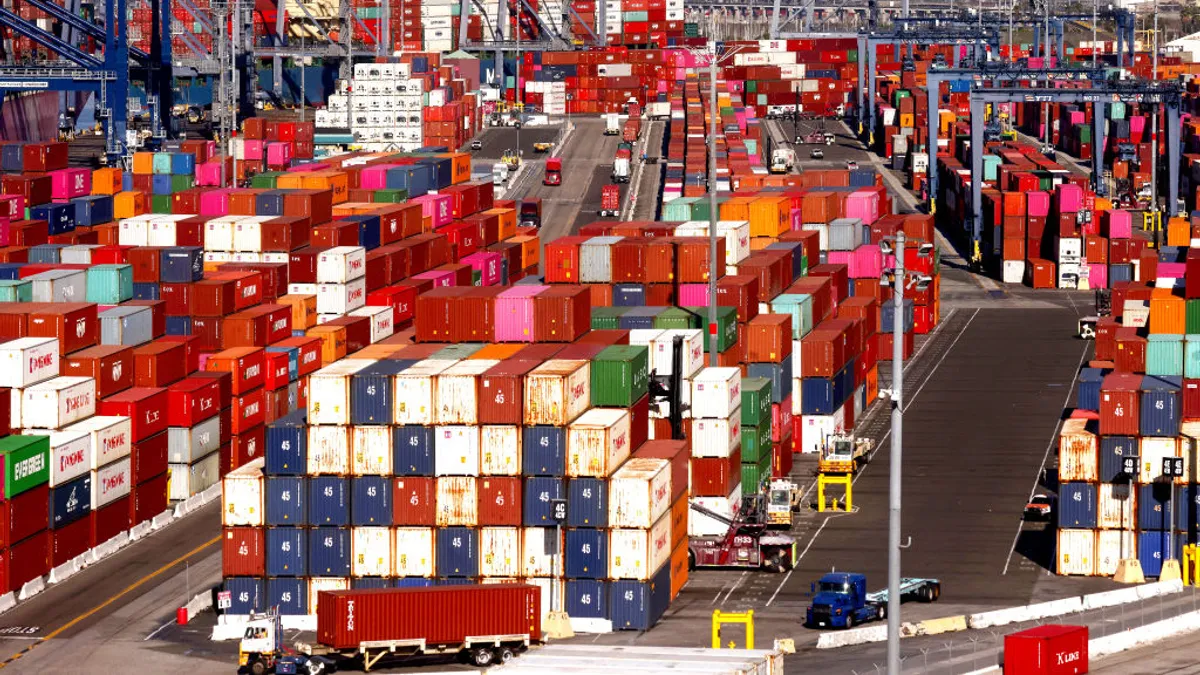Editor's note: This story is part of a series on the trends, opportunities and challenges supply chains will face in 2022. Read the full outlook here.
Like grocers across the country, Karns Foods in Pennsylvania is grappling with rising prices and a rotating cast of supply chain shortages. That lack of control has been tough to swallow for Scott Karns, the 10-store company's chief executive.
"We order 2,000 cases and we might get 1,200," he said. "It's very frustrating for our customers to explain to them why they can't get exactly the flavors and the sizes they want."
The company is managing as best it can, Karns said. To combat price increases, Karns' stores are stocking their aisles with more private label products, which offer lower price points. To deal with supply shortages, managers are buying surplus quantities of items like toilet paper and pasta sauce when they can and offering shoppers a limited assortment in strained categories.
Karns said the company is also trying to source more products locally, including pork, which used to come from a Midwest supplier and now comes from an in-state one. In May, the grocer will begin sourcing around two-thirds of its beef supply from a handful of local farms that will exclusively supply Karns' stores.
So far, Karns noted, shoppers have rolled with the changes, but he's not sure how long that will last. "The basket is going to get more expensive as the year goes on," he said.
Retailers are nervously watching their shoppers as rising prices and out-of-stocks continue to plague their aisles. According to recent news reports and interviews, the main impact of these prolonged disruptions to date has been shoppers buying lower-priced items and grumbling about empty shelves.
But loyal consumers could reach a tipping point later this year, companies fear, and switch to stores that offer better prices or different products. During its third-quarter earnings call earlier this month, Albertsons executives noted the pressure competitors put on any decisions the grocer makes around pricing, and said that while its shopper loyalty is "strong" right now, the company is remaining watchful.
In an Ipsos survey of 1,000 consumers released in early December, 45% reported buying items from a store other than their primary grocer at least once a month thanks to supply strains or a poor online ordering experience. Eighteen percent of households with kids said they've changed to another primary grocer because of these factors.
"There's enough competition out there that consumers are changing their behaviors if what they need isn't in stock," said Mike Murphy, a vice president with Ipsos.
Krishnakumar Davey, president of client engagement with IRI, said the research firm is monitoring consumer elasticity, which measures shoppers sensitivity to price changes, "extremely closely." After a period of low elasticity earlier in the pandemic, when stimulus checks, child tax credits and at-home lockdowns fueled higher spending, that metric has started to rise to pre-COVID levels in many categories, he said. As of early January, breakfast meats and coffee were showing price sensitivity in line with those seen before the global health crisis, while hot cereal and candy were showing higher elasticity than pre-COVID, Davey said.
Across many categories, consumer elasticity is still lower than before the pandemic, Davey said, suggesting retailers have room to pass along price increases from suppliers, which have been hit with higher wages, shipping disruptions and other pressures. But retailers are concerned that the end of federal aid programs, like the expanded child tax credit that expired at the end of 2021, coupled with prices rising at a faster clip, could magnify consumers' frustrations.
Food-at-home prices rose 6.5% last year, according to the U.S. Bureau of Labor Statistics, and manufacturers are passing along additional increases beginning this month. IRI projects prices will rise an average of 5% in the first half of this year.
"What [retailers] are apprehensive about is that some of the stimulus is drying out, and price increases are going through a lot more this year than last year," Davey said. "They're saying we know that people like to eat at home, but people can substitute."
"We order 2,000 cases and we might get 1,200. It's very frustrating for our customers to explain to them why they can't get exactly the flavors and the sizes they want."

Scott Karns
CEO, Karns Foods
Staying 'agile' amid price increases
Although the root causes of inflation are beyond retailers' control, there are ways to effectively manage these price increases, experts said. Executives at Albertsons and other grocers have spoken in recent weeks about holding back increases on essential goods and key items while letting them flow through on more discretionary purchases.
Davey said IRI's scan data shows grocers are keeping down prices on fresh goods like milk, eggs and meat and increasing prices across center store categories. They're also pulling back on price promotions due to supply shortages and other challenges. He said that, percentage-wise, the center store price increases appear relatively the same across discount, mass and traditional retailers — which is somewhat surprising, Davey said, as he expected low-price retailers to hold back in an effort to win over comparison shoppers. But that could soon change.
Davey said retailers that are able to push personalized coupons and other promotions to price-sensitive shoppers are doing so.
"Right now, I think the main strategy is to give the discount to the buyers who need it," he said.
Steve Bishop, managing partner and co-founder of consulting firm Brick Meets Click, said retailers are using technology to spot price gaps and identify high-value items where they should be price competitive. Companies need to be particularly "agile" in 2022, he said, because the combination of high demand on certain items and supply shortages can make inflation appear quickly anywhere in the store.
"In the coming year, it will be even more important to change prices quickly to minimize any price vulnerability from higher prices that negatively impact sales or lower prices that negatively impact profit," he wrote in an email.
A value-price image can go a long way, sources said, even if prices overall have gone up. Marco Di Marino, director of consulting firm AlixPartners' retail and grocery division, said retailers are making selective price cuts and promoting key items where they've kept inflation from trickling in. Earlier this month, Winn-Dixie announced it's dropping prices prices by an average of 15% on more than 150 of its "most-shopped" items.
Retailers are also adding more store brands and value-priced items to their shelves, said Di Marino.
Krasdale Foods, which offers distribution and marketing services to independent retailers in New York and New Jersey, is seeing higher private label demand from retailers it serves, said Dennis Hickey, chief merchandising officer with the company. But Krasdale's private label suppliers are struggling with the same supply-chain shortages national brands face — like shortages of tin and other raw materials — meaning sometimes they don't have the products in stock.
Many of the retailers Krasdale works with are in the New York City area, where there aren't many discount players like Walmart. That's helped stores hold onto customers, he said, though companies are still carefully watching shoppers' behavior over the coming months.
"We're keeping a very close eye on trip frequency," Hickey said.
Learning to do more with less
Retailers learned early in the pandemic how to deal with supply shortages and communicate those to shoppers. The omicron variant, however, has once again accelerated out-of-stocks that are often impossible to predict as suppliers and distributors contend with worker absences and other challenges.
Executives are hopeful supplies will normalize beginning in February, after omicron has ebbed. Until then, retailers like Go Grocer in Chicago are having to limit their assortment and shuttle goods between stores to fill in product gaps. Gregory Stellatos, co-founder and co-owner of the Chicago-based chain, said all the supply shuffling during the pandemic has made shoppers less brand loyal.
"During this time, I think private label and emerging brands are the two winners," he said.
Hickey, meanwhile, said independent retailers have had to be very resourceful in order to get the supplies they need. They're cutting assortments by nearly half in some areas, he said. If Krasdale doesn't have an item they need, he said, they'll find another way to get it.
"Instead of carrying 25 flavors of Ocean Spray juice, they may be down to 15 or 16," he said. "They're spread out a little more, and maybe they've changed their allocations, but our retailers will go anywhere to get product when they need to fill shelves."
Karns said shoppers at his stores have responded so well to limited assortments that he's planning to continue the strategy long-term. "How many sizes of Hidden Valley Ranch do we really need?" he said.
The supply chain squeeze over the past two years has prompted Karns to make other long-term changes. After years of contemplating starting its own beef supply line, the grocer finally got started a year ago. It partnered with a local farm-management organization and is now overseeing Angus cattle operations at 15 family farms across six counties.
Karns Pennsylvania Preferred Beef selections will hit stores in May, Karns said, and have their own dedicated section. All told, the operation will account for around 70% of the grocer's beef needs, and could get close to 80% after adding several more farms. He said the new line will carry prices that are equal to its current beef selections.
"I can go out and visit the herds, which is something I've never been able to do in my 40 years in the supermarket business," Karns said.



